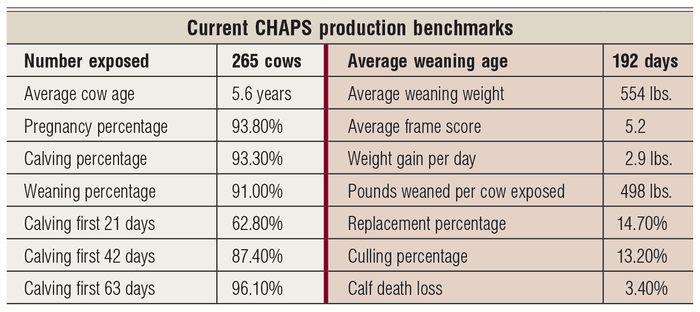It seems like progress likely will be measured in terms of balanced production relative to cost, rather than increased production.
January 2, 2018

Given the multifaceted challenges associated with commercial cow-calf production, it’s hard to think that the easiest part of the journey may be coming up in the rearview mirror.
“Future improvement within agriculture — plant and animal — will be a balancing act, weighing inputs and costs against the potential improvement,” says Kris Ringwall, Extension beef specialist with North Dakota State University (NDSU).
In recent editions of his insightful “BeefTalk ” column,Ringwall shared benchmark data from the Cow Herd Appraisal Performance Software (CHAPS) program. North Dakota State University Extension Service and the North Dakota Beef Cattle Improvement Association collect and analyze the CHAPS data to calculate five-year rolling benchmark values for average herd performance.
The overall production profile of current benchmarks represents a goal many commercial producers would be happy to attain (see graphic).

While some producers aim to achieve and maintain balanced production levels, Ringwall says, “My observation has been that the message was always one of increase: increase growth, increase reproductive success, increase yield, increase efficiency, increase number of cows serviced, increase, increase, increase.”
Although input costs often are considered, Ringwall explains, “Each enterprise determines its own input costs, adjusts the incoming product price and calculates the impact on subsequent profit margin. As long as a margin for profit exists, the green light is generally on.”
Pondering the CHAPS data, Ringwall wonders if there’s much more cost-effective improvement to the values left to be made.
“Perhaps the benchmark values for performance traits are indicative of threshold values that commercial beef producers can attain for relative performance within the herd, including growth, reproduction and livability.”
Consider weaning weight per cow exposed. Since 2003, CHAPS benchmark values range between 494 and 507 pounds. The range is 494 to 498 pounds since 2013. Calf death loss since 2003 ranges from 3.1% to 3.9%.
Such static performance is found in other commercial data, such as that of the Southwest Standard Performance Analysis (SPA). Critical measures of herd performance like calves weaned per cow and pounds weaned per cow exposed change little over time, and in a narrow window.
Paradoxically, notwithstanding this year’s set of unique circumstances, average carcass weights continue to grow — about 250 pounds in the last 50 years at about 5 pounds per year, according to Derrell Peel, Extension livestock marketing specialist at Oklahoma State University.
Genetics, technology and management always seem able to grow more pounds after weaning.
Sooner or later, logic suggests a threshold will be reached in fed cattle and carcass weights, too. Rather than having to do with limitations borne by technology or packinghouse infrastructure, it might simply have to do with sheer weight, ultimately overwhelming the inherent skeletal size and organ mass of cattle.
While there’s plenty of running room left in some herds, for others progress likely will be measured in terms of balanced production relative to cost, rather than increased production.
About the Author(s)
You May Also Like





